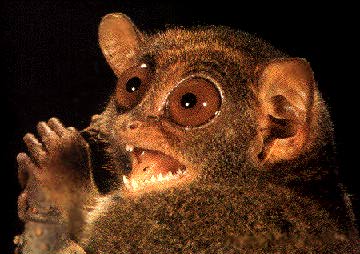Diurnal, Nocturnal, Cathemeral Activity
Patters
Diurnal primates are active during
the day. The benefits include better visual foraging and visual communication.
However, diurnal primates face increased predation, possible heat stress,
and competition for food from birds and other primates.
Nocturnal primates are primarly
active at night. They are better protected from predators and have  fewer
competitors for food. However, they cannot forage as extensively and socializing
is difficult. Nocturnal primates tend to utilize vocal communication during
hours of darkness when sound travels better due to humid night air. Nocturnal
primates also have enlarged eyes that allow more light to penetrate (see
Tarsier to the right).
fewer
competitors for food. However, they cannot forage as extensively and socializing
is difficult. Nocturnal primates tend to utilize vocal communication during
hours of darkness when sound travels better due to humid night air. Nocturnal
primates also have enlarged eyes that allow more light to penetrate (see
Tarsier to the right).
Many primates are actually active
throughout a twenty-four hour period on a sporadic basis. This is a pattern
known as CATHEMERAL activity. This type of activity pattern means these
primates sleep periodically throughout the day.
Can you think of possible benefits
that would come from a Cathemeral activity pattern?
 fewer
competitors for food. However, they cannot forage as extensively and socializing
is difficult. Nocturnal primates tend to utilize vocal communication during
hours of darkness when sound travels better due to humid night air. Nocturnal
primates also have enlarged eyes that allow more light to penetrate (see
Tarsier to the right).
fewer
competitors for food. However, they cannot forage as extensively and socializing
is difficult. Nocturnal primates tend to utilize vocal communication during
hours of darkness when sound travels better due to humid night air. Nocturnal
primates also have enlarged eyes that allow more light to penetrate (see
Tarsier to the right).